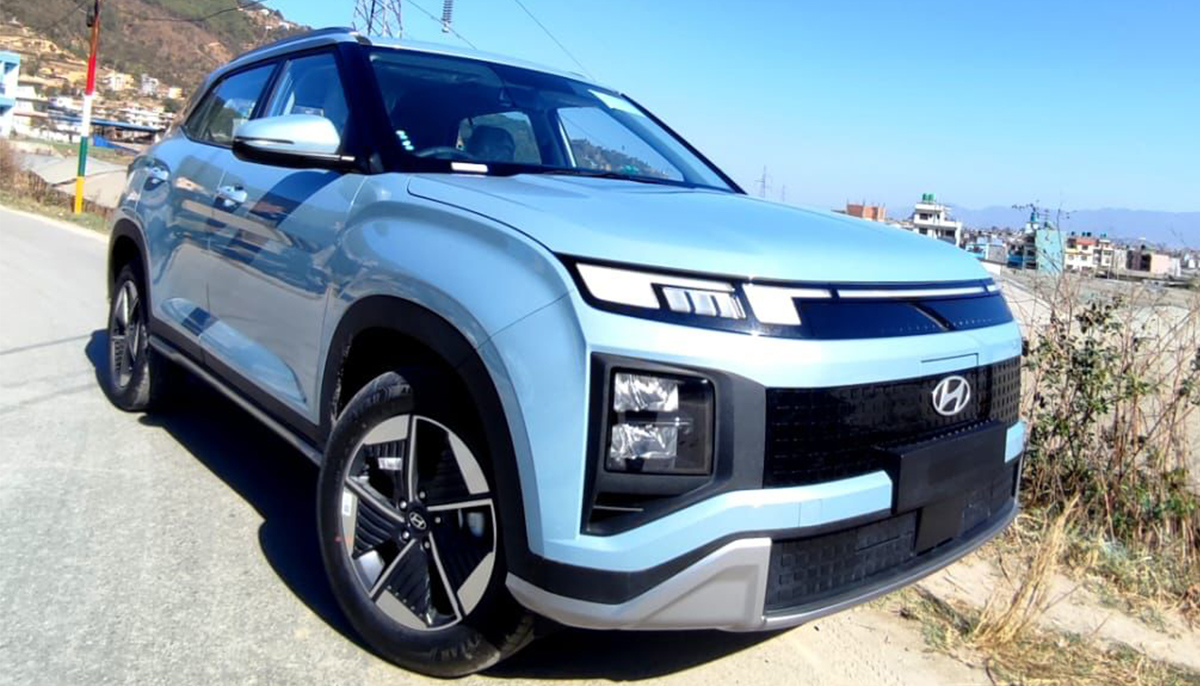The Hyundai Creta has long been a dominant force in Nepal’s compact SUV market, winning buyers over with its strong design, practicality, and reliability. Now, Hyundai is electrifying this successful nameplate with the launch of the Creta Electric. Although it enters Nepal’s EV segment a little later than some rivals, the Creta Electric brings a compelling blend of performance, range, and technology. However, it faces stiff competition from established Chinese EV players like BYD and MG, who have already carved out a significant presence in the market.
Power, Performance, and Range
The Creta Electric is available in two battery configurations. The larger 51.4 kWh battery delivers an impressive 126 kW (168 bhp) of power and boasts an ARAI-certified range of 473 km, making it ideal for long commutes and highway travel. For those looking for a more budget-friendly option, the smaller 42 kWh battery generates 99 kW (132 bhp) and offers a range of 390 km. Despite being an electric SUV, the Creta Electric delivers swift acceleration, reaching 0-100 km/h in just 7.9 seconds. To ensure consistent performance, especially in colder conditions, Hyundai has equipped it with a battery heater, optimizing efficiency across different climates.
Both battery variants of the Creta Electric are powered by NMC (Nickel Manganese Cobalt) battery technology, which is known for providing a balance of high energy density, longer life, and greater efficiency, contributing to both the vehicle’s range and performance.
Fast Charging and Energy Efficiency
Charging the Creta Electric is seamless, thanks to multiple charging options. The included 11 kW smart wall box charger allows a full charge from 10% to 100% in just 4 hours, making overnight home charging convenient. For those needing faster turnaround times, the Creta Electric supports DC fast charging, which powers the battery from 10% to 80% in just 58 minutes. Enhancing efficiency further, Hyundai has incorporated Active Air Flaps (AAF) to improve aerodynamics and energy utilization, ensuring that every bit of battery power is used effectively.
Packed with Safety and Advanced Tech
Hyundai has prioritized safety in the Creta Electric, integrating over 72 advanced safety features. It comes equipped with six airbags, all-wheel disc brakes, and an electronic parking brake (EPB) with auto-hold functionality. Hill-Start Assist Control (HAC) and Hill Descent Control (HDC) provide additional confidence on steep inclines, while the Tyre Pressure Monitoring System (TPMS) ensures optimal tire performance. Enhancing situational awareness, the SUV features a surround-view monitor (SVM) and a blind-spot view monitor (BVM), along with rain-sensing wipers and front parking sensors.
Adding to its safety credentials, the Creta Electric includes Hyundai’s Advanced Driver Assistance Systems (ADAS) Level 2, which brings features like Lane Keeping Assist, Forward Collision Warning, Blind Spot Collision Warning, and Smart Cruise Control with stop-and-go functionality. The regenerative braking system is also linked to ADAS, adjusting braking intensity based on traffic conditions. Additionally, i-Pedal technology allows drivers to accelerate, decelerate, and stop using just a single pedal, enhancing the overall driving experience. Structurally, the Creta Electric is built for durability, with 75% of its body composed of Advanced High Strength Steel (AHSS) and High Strength Steel (HSS), further reinforced with extensive hot stamping for superior crash protection.
Feature-Packed Interior with Luxury Touches
Inside, the Creta Electric boasts a modern and feature-rich cabin designed for comfort and convenience. It comes equipped with dual 10.25-inch curved displays—one serving as a fully digital instrument cluster and the other as an infotainment touchscreen. A premium Bose 8-speaker sound system ensures an immersive audio experience. Hyundai’s Bluelink technology adds over 70 connected car features, allowing remote vehicle monitoring, OTA updates, and enhanced security features.
To enhance passenger comfort, the Creta Electric features touch-type dual-zone automatic climate control, ventilated front seats with memory function, and a cooled glove box along with a cooled armrest storage compartment. The panoramic sunroof can be operated via voice commands, offering up to 268 different control functions. Hyundai has also introduced Vehicle-to-Load (V2L) functionality, allowing users to power small appliances inside or outside the vehicle. For added convenience, the Creta Electric supports a digital key that can be accessed via smartphones and smartwatches.
How It Stacks Up Against Competitors
Hyundai will position the Creta Electric in a competitive price range, expected to be between Rs 55 Lakh and Rs 65 Lakh. However, it enters a market where brands like BYD and MG have already established a strong foothold.
The BYD Atto 3, for instance, has been a successful product in Nepal, priced at Rs 67.80 Lakh for the 60.48 kWh variant, which offers a WLTP-certified range of 420 km. The Atto 3 also benefits from BYD’s signature Blade Battery technology, known for its safety and longevity.
On the other hand, the upcoming MG S5 EV presents itself as a more affordable alternative, with prices starting at Rs 46.99 Lakh for the 49.1 kWh battery, which delivers a 340 km WLTP range. The higher-end variant, priced at Rs 57.99 Lakh, comes with a 62.2 kWh battery featuring CATL’s ultra-thin LFP technology—the slimmest battery ever seen in Nepal. With such strong competition, Hyundai will need to focus on strategic pricing, financing options, and a well-established charging network to make the Creta Electric a viable choice in this crowded segment.
Verdict: Can the Creta Electric Make an Impact?
Hyundai’s late entry into Nepal’s EV market means it has significant ground to cover against well-established competitors. However, the Creta Electric brings several advantages to the table, including premium features, a strong safety package, Hyundai’s global brand reputation, and a reliable after-sales network. While the competition offers aggressive pricing and innovative battery technologies, Hyundai’s ability to position the Creta Electric effectively—both in terms of pricing and charging infrastructure—will determine its success in Nepal’s growing EV landscape.
Would you consider the Creta Electric over the BYD Atto 3 or MG S5 EV? Let us know in the comments!



















